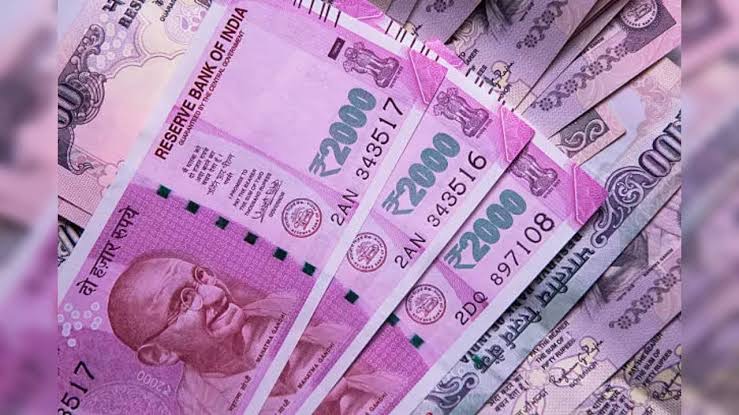In a surprise move, Reserve Bank of India on Friday said it has been decided to withdraw Rs 2,000 bank notes from circulation. However, RBI said bank notes of Rs 2,000 denomination will continue to be legal tender.
Reserve Bank of India explained the rationale behind the move being “banknotes in other denominations are available in adequate quantities”. RBI said these notes are to be exchanged at banks on or before September 30, 2023.
“Members of the public can continue to use Rs 2,000 banknotes for their transactions and also receive them in payment. However, they are encouraged to deposit and/or exchange these notes on or before September 30, 2023,” said RBI.
The central bank has asked the public to deposit Rs 2,000 bank notes into their bank accounts and/or exchange them into banknotes of other denominations at any bank branch, which will be done free of cost.
Deposit into bank accounts can be made in the usual manner, that is, without restrictions and subject to extant instructions and other applicable statutory provisions, RBI said.
“In order to ensure operational convenience and to avoid disruption of regular activities of bank branches, exchange of Rs 2,000 bank notes into bank notes of other denominations can be made up to a limit of Rs 20,000 at a time at any bank starting from May 23, 2023,” the RBI said.
Also, the facility for exchange of Rs 2,000 bank notes up to the limit of Rs 20,000 at a time shall also be provided at the 19 Regional Offices (ROs) of RBI having Issue Departments from May 23, 2023.
In January 2014, the RBI announced withdrawal from circulation all bank notes issued prior to 2005.
“About 89% of the Rs 2,000 denomination banknotes were issued prior to March 2017 and are at the end of their estimated life-span of 4-5 years. The total value of these banknotes in circulation has declined from Rs 6.73 lakh crore at its peak as on March 31, 2018 (37.3% of notes in circulation) to Rs 3.62 lakh crore constituting only 10.8% of notes in circulation on March 31, 2023.
It has also been observed that this denomination is not commonly used for transactions. Further, the stock of banknotes in other denominations continues to be adequate to meet the currency requirement of the public,” RBI said in a statement.
“Rs 2,000 currency note will remain legal tender after September 30 too. RBI expects that four-month time is enough for people to exchange notes with the banks. Most of the Rs 2,000 notes that are in circulation will return to banks within the given time frame of September 30. This is a routine exercise of RBI and people need not panic,” ANI quoted government sources minutes after the highest-denomination banknote was withdrawn from circulation.
The Rs 2,000 denomination banknote was introduced in November 2016, primarily to meet the currency requirement of the economy in an expeditious manner after the withdrawal of the legal tender status of all Rs 500 and Rs 1,000 banknotes in circulation at that time.
“In order to ensure operational convenience and to avoid disruption of regular activities of bank branches, exchange of Rs 2,000 banknotes into banknotes of other denominations can be made upto a limit of Rs 20,000 at a time at any bank starting from May 23, 2023,” RBI said.
Karthik Srinivasan, Senior Vice President Financial Sector Ratings, ICRA said: “As witnessed during demonetisation, we expect the deposit accretion of banks could improve marginally in near term. This will ease the the pressure on deposit rates hikes and could also result in moderation in short-term interest rates.”
Can RBI’s decision to withdraw Rs 2,000 note be called demonetisation? That’s a tricky question to answer. Technically, no. It’s not demonetisation because the RBI is not making the notes worthless. The idea is RBI takes back all the Rs 2,000 notes from the economy and probably destroys them. RBI’s best hope is that there won’t be any Rs 2,000 note floating in the economy after September 30 because it would have got it all back.
However, if the RBI does not get back all the Rs 2,000 notes, then there remains the question if these notes will continue to remain a legal tender. Now, if such a situation were to arise, which is not completely unlikely, then the RBI probably has the option to either stretch the deadline to return the notes or issue a notification that Rs 2,000 notes is no longer valid. RBI sources have told Business Today that RBI does not have the power to demonetise.
So, perhaps, the government might have to step in and formally say that the Rs 2,000 note is no longer valid. But since there’s likely to be very less number of such notes in circulation by September 30, assuming people return the notes, it will definitely not be as alarming a deal as the previous demonetisation. But, in best case scenario, the RBI will hope that such a situation does not arise and it gets all the Rs 2.000 notes back.
(With the inputs of Business Today).


